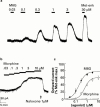Morphine-6 beta-glucuronide has a higher efficacy than morphine as a mu-opioid receptor agonist in the rat locus coeruleus
- PMID: 11090116
- PMCID: PMC1572456
- DOI: 10.1038/sj.bjp.0703697
Morphine-6 beta-glucuronide has a higher efficacy than morphine as a mu-opioid receptor agonist in the rat locus coeruleus
Abstract
1. The pharmacological properties of the active morphine metabolite, morphine-6 beta-D-glucuronide (M6G), and the parent compound were compared in rat locus coeruleus neurons by electrophysiological recording in brain slices. 2. M6G and morphine activated potassium currents in voltage clamped neurons, which were blocked by the opioid receptor antagonist naloxone. 3. Both M6G and morphine behaved as partial agonists that produced maximal responses smaller than the system maximum, which was measured using [Met(5)]-enkephalin. M6G produced a larger maximal response (78%) than morphine (62%), which we estimated was due to a 2 - 4 fold difference in the relative efficacy of the agonists. 4. 3-O-methoxynaltrexone, which has been reported to behave as a selective antagonist of a M6G preferring receptor, was equally effective at blocking currents produced by M6G and the selective mu-opioid receptor agonist DAMGO. 5. M6G currents were occluded by a prior application of morphine, and were reduced when mu-opioid receptors were desensitized by using [Met(5)]-enkephalin. 6. Morphine-3 beta-D-glucuronide did not affect action potential firing or membrane currents in locus coeruleus neurons and had no effect on currents produced by M6G. 7. These results show that the relative efficacy of M6G is higher than morphine in locus coeruleus neurons, contrary to what has been shown using mu-opioid receptors expressed in cell clones.
Figures






References
-
- ABBOTT F.V., FRANKLIN K.B. Morphine-6-glucuronide contributes to rewarding effects of opiates. Life Sci. 1991;48:1157–1163. - PubMed
-
- ABBOTT F.V., PALMOUR R.M. Morphine-6-glucuronide: analgesic effects and receptor binding profile in rats. Life Sci. 1988;43:1685–1695. - PubMed
-
- BLACK J.W., LEFF P. Operational models of pharmacological agonism. Proc. R. Soc. B. 1983;220:141–162. - PubMed
-
- BROWN G.P., YANG K., KING M.A., ROSSI G.C., LEVENTHAL L., CHANG A., PASTERNAK G.W. 3-Methoxynaltrexone, a selective heroin/morphine-6beta-glucuronide antagonist. Febs. Lett. 1997a;412:35–38. - PubMed
-
- BROWN G.P., YANG K., OUERFELLI O., STANDIFER K.M., BYRD D., PASTERNAK G.W. 3H-morphine-6beta-glucuronide binding in brain membranes and an MOR-1-transfected cell line. J. Pharmacol. Exp. Ther. 1997b;282:1291–1297. - PubMed
Publication types
MeSH terms
Substances
LinkOut - more resources
Full Text Sources
Research Materials
Miscellaneous

